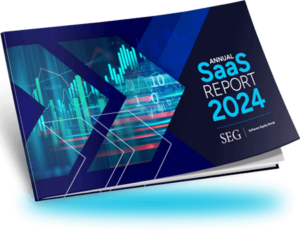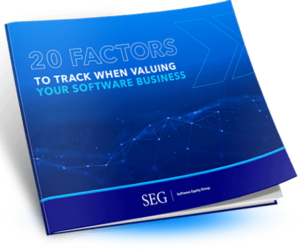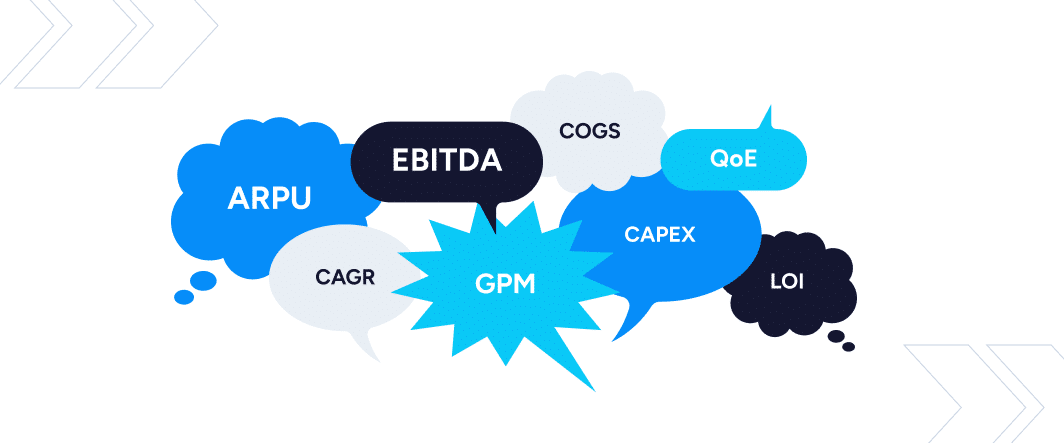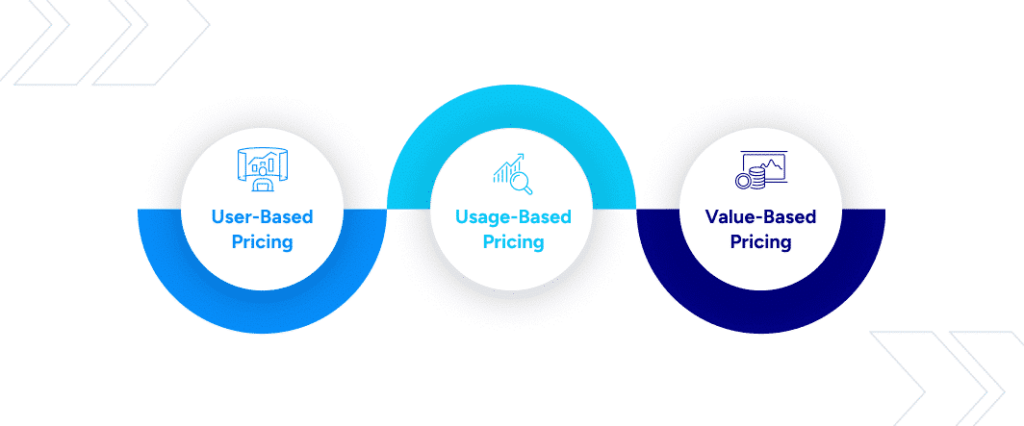- Company
Featured Resource
CLIENT STORYModern Message
To Real Estate
Giant RealPage
- Sectors
Featured Industry Report
EXPERT SERIESManufacturing Software
Report – Part 2
- Research
Featured Resource
FEATURED REPORTThe SEG 2024
Annual SaaS Report
- Tools
Featured Resource
WHITEPAPER20 Factors to Track When Valuing Your
SaaS Company
- Blog
Useful Software Industry Acronyms for Executives

During negotiations and discussions with advisors or potential buyers, an understanding of key financial and operational metrics is crucial. Being aware of these terms and their implications can significantly enhance your ability to navigate negotiations, make informed business decisions, and demonstrate a comprehensive understanding of your company’s value.
The following acronyms are frequently used to assess a company’s performance, financial health, and market positioning. Continue reading to discover the most common software industry acronyms categorized into financial metrics, operational metrics, and those relevant to the M&A process.
Financial Metric Acronyms
Financial acronyms will frequently appear in documents and conversations throughout the M&A process. Understanding these acronyms will not only enhance your comprehension of crucial financial discussions but also contribute to more effective communication. The following acronyms are among the most common ones our clients encounter.
ACV: Annual Contract Value
ACV is the total annual value of customer contracts. ACV enables annual or multi-year contracts to be benchmarked against other annualized metrics.
ARPU: Average Revenue Per User
Measures the revenue generated from each active user, typically monthly. ARPU is calculated by dividing monthly recurring revenue (MRR) by the number of active customers.
ARR: Annual Recurring Revenue
ARR is a metric for subscription-based models to measure average recurring revenue. It annualizes monthly recurring revenues to provide insight into growth on a run-rate basis. ARR is calculated by multiplying MRR by 12.
CAC: Customer Acquisition Cost
Customer acquisition cost (CAC) measures the amount of money a business spends to acquire a new customer. You can calculate CAC on a monthly, quarterly, or yearly basis.
CAGR: Compound Annual Growth Rate
CAGR represents the average annual growth rate. It determines a more constant rate of return on business growth that naturally fluctuates over time. CAGR can be used to compare your performance against industry averages.
DCF: Discounted Cash Flow
Estimates a company’s value and forecasts future cash flow by incorporating the time value of money. DCF is used when making investment decisions and understanding a business’s current and future value.
EBITDA (Cash-Adjusted): Earnings Before Interest, Taxes, Depreciation & Amortization
You are likely familiar with EBITDA (earnings before interest, taxes, depreciation, and amortization), used to measure profitability. However, most should be aware of cash-adjusted EBITDA, the deferred revenue that provides a preview of EBITDA yet to come.
FCF: Free Cash Flow
The amount of cash a company generates after deducting any capital expenditures. FCF is the cash available on hand to pay investors and creditors.
GPM: Gross Profit Margin or Gross Margin
Gross profit margin looks at gross profit as a percentage of total revenue and is the amount available to pay operating expenses and reinvest into the business. Since SaaS businesses typically have relatively little cost associated with servicing revenue, this leads to a generally high gross margin.
GRR: Gross Revenue Retention
GRR (not to be confused with Net Revenue Retention) measures the percentage of revenue retained after accounting for customer losses, providing insight into a company’s ability to maintain its customer base.
LEARN MORE: Gross Retention & Gross Profit: What Our Survey Reveals About These 2 Key Metrics
IRR: Internal Rate of Return
IRR is a metric used in financial analysis to estimate the profitability of potential investments. It is a discount rate that makes the net present value (NPV) of all cash flows equal to zero in a discounted cash flow analysis.
LTV: Lifetime Value or Customer Lifetime Value
This value is the gross profit a single customer is predicted to generate over their engagement with the company. Used in conjunction with CAC, the LTV:CAC ratio is an indication of both customer profitability and marketing effectiveness.
MRR: Monthly Recurring Revenue
MRR measures the recurring revenue generated monthly by subscription customers. To calculate MRR, multiply the average revenue per user by the total users that month or divide ARR by 12.
NDR: Net Dollar Retention
NDR is a metric that calculates the revenue retained from existing customers after accounting for churn, contraction, and expansion, reflecting a company’s growth from its existing customer base.
NI: Net Income
Net income is the business’ earnings after deducting COGS and operating expenses (including taxes, interest, and wages).
NOI: Net Operating Income
This is pre-tax income after deducting operating costs. The metric indicates the amount of cash flow generated after expenses.
NPV: Net Present Value
NPV measures the current value of the projected cash flow of investments and projects. It uses the discounted rate to determine the present-day value of forecasted cash flows plus related initial expenses to evaluate the investment.
NRR: Net Revenue Retention
NRR, similar to NDR, measures the net change in revenue from existing customers, accounting for upsells, cross-sells, and churn, indicating the overall health of a company’s customer relationships.
P&L: Profit & Loss Statement
A summary of the revenue, expenses, and other costs incurred over a month, quarter, or fiscal year. The cash accounting or the accrual method is used to prepare P&L statements.
QoE: Quality of Earnings
QoE is a due diligence process that assesses the accuracy and sustainability of a company’s reported earnings, ensuring transparency and reliability.
R40: Rule of 40%
Software companies use the Rule of 40 to evaluate overall growth and profitability. A 40% combined EBITDA margin and revenue growth rate is considered healthy.
TCV: Total Contract Value
The lifetime value of a contract, including the total revenue accumulated from the contract.
WACC: Weighted Average Cost of Capital
This calculation measures a business’s cost of capital. WACC represents the average amount a firm expects to pay its investors, including creditors and stockholders.
Operational Acronyms
Overlooking operational acronyms might unintentionally affect agreement terms and other important aspects. To avoid missing out, we suggest SaaS operators familiarize themselves with the following acronyms.
CAPEX: Capital Expenditure
CAPEX represents funds used by a company to acquire, upgrade, and maintain physical assets such as property, buildings, or equipment.
COGS: Cost of Goods Sold
The costs required to serve your product to your customer. For software companies, expenses included in COGS are those directly attributed to the delivery of software or services provided, including hosting expenses, costs for third-party software, and personnel costs for DevOps employees, the professional services team, and the customer support team, among others.
FTE: Full-Time Equivalent
You are likely familiar with FTE; however, it is important to understand how to allocate labor expenses into COGS correctly.
G&A: General & Administrative
G&A is an operating expense that includes the daily costs of operating a business regardless of sales or other business activity. G&A expenses include rent, utilities, insurance, and office supplies. G&A is typically measured as a percent of total revenue.
OPEX: Operating Expenditures
Operating Expenditures are the costs a business must make to run normal commercial operations, including employee wages, rent, and utilities.
R&D: Research & Development
R&D is an operating expense that includes a business’s activity in gathering knowledge for innovation or improving existing offerings. R&D is typically measured as a percentage of total revenue.
S&M: Sales and Marketing (Expense)
Sales & Marketing is an operating expense, used as a percentage of revenue, that includes the activity a business participates in to generate leads and convert them into customers.
M&A Process Acronyms
Be attentive to M&A acronyms, as your advisor and potential investors and buyers may frequently use these. Ensuring you understand these acronyms is essential to prevent inadvertently missing key points when in the process.
DD: Due Diligence
Due Diligence is the comprehensive process of investigating and evaluating a company’s financials, operations, and other aspects before finalizing a business transaction.
IOI: Indication of Interest
An Indication of Interest (IOI) is a non-binding expression from a potential buyer outlining basic terms and conditions for acquiring a target company, signaling a serious intention to pursue a transaction.
LOI: Letter of Intent
A Letter of Intent is a formal document outlining the preliminary terms and conditions of a proposed business transaction, expressing a serious intention to proceed.
PIIA: Proprietary Information and Inventions Agreement
A PIIA is a legal contract that protects a company’s confidential information and intellectual property, often required for employees.
Other Resources to Help You Prepare for an Exit
Before embarking on the M&A process or organizational growth, invest some time in expanding your knowledge. Familiarize yourself with the terms frequently employed in M&A procedures and negotiations. Explore the comprehensive list of M&A terms provided here to ensure you are well-prepared for the complexities of the journey ahead.
As you start to get familiar with the depths of the M&A process, turn to our research for valuable insights that can help arm you for a future exit. Find comprehensive SaaS analyses, strategic advice, and considerations, plus expert perspectives that will empower you with the knowledge needed to navigate M&A negotiations successfully. See our latest research to stay informed.









